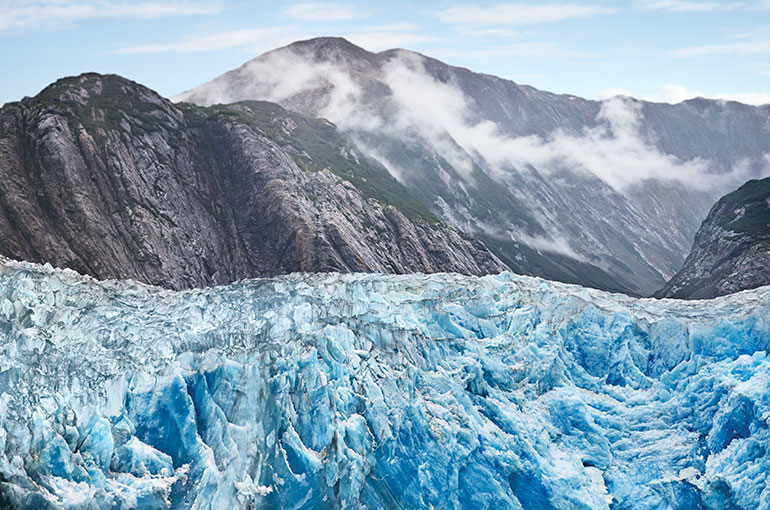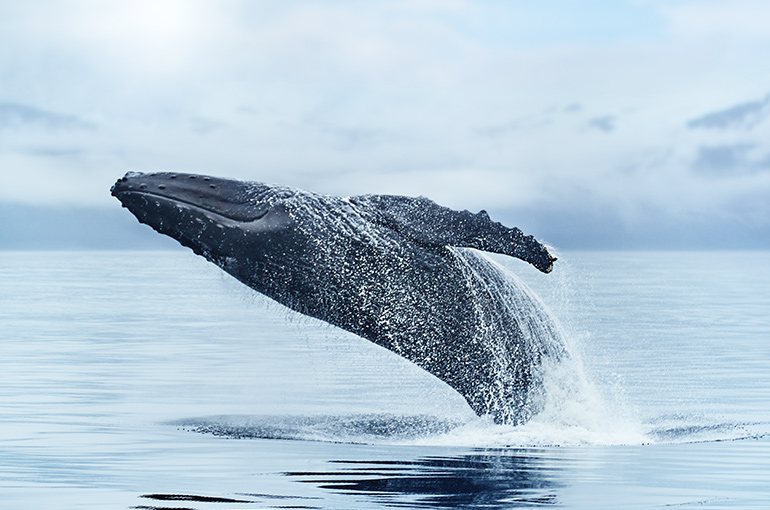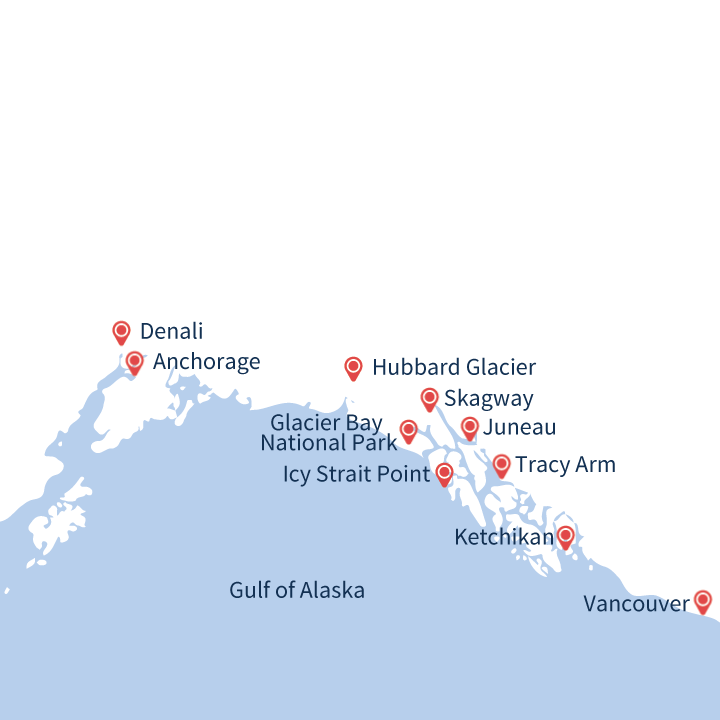Alaska
No journey stays with you, mind and soul, like an expedition through Alaska. From the blue ice of massive glacial fields to the stunning grandeur of the scenery and wildlife, everything in Alaska is big, bold and absolutely breathtaking. Including the adventures.
Denali Alaska
The name ''Denali'' means ''The Great One'' in the native Athabascan language. At 20,320 feet above sea level. Denali is the highest peak in North America and is surrounded by one of the world's most spectacular wildlife sanctuaries. Denali National Park is home to many types of wildlife including caribou, moose, wolves, Dall sheep, bald eagles, and the mighty grizzly bears. Leave it to Princess to offer excursions for all types of adventurers. Enjoy a scenic float down the Nenana River or an exhilarating jetboat safari. Play a round of golf in the Midnight Sun, or rise above it on a thrilling flightseeing tour. Hike in the backcountry, hoot and holler at the Music of Denali Dinner Theatre, or visit an Iditarod champion's dog kennel ... and hold the puppies! It's all up to you. Let us introduce you to Denali National Park - up close!
Anchorage (Whittier) Alaska
Whittier, approximately 65 miles southeast of Anchorage, lies nestled at the base of the Chugach Mountains bordering Passage Canal. Established as a World War II port for cargo and troops of the Alaska Command, Whittier remained activated until 1960. Today, Whittier's economy and its 290 residents rely largely on the fishing industry, the port and, increasingly, on tourism. Once accessible only by boat or via a war-era railway tunnel, The Anton Anderson Memorial Tunnel was recently enhanced to accommodate highway traffic as well, making it the longest highway/rail tunnel in North America at 2.5 miles. Named for the poet John Greenleaf Whittier, the community is also the gateway to spectacular Prince William Sound, with its magnificent tidewater glaciers and abundant marine life. Whittier tours are available to passengers on back-to-back voyages who will stay onboard the ship and cruise back to Vancouver as well as guests ending their cruise in Whittier with an evening flight out of Anchorage on the day of disembarkation or an overnight in Anchorage after their cruise. Whittier tours are only available to cruisetour guests who spend the first night of their package in Anchorage. Other cruisetour guests cannot take an excursion as they would miss the transfer their next destination.
Hubbard Glacier Alaska (Scenic Cruising)
Nicknamed the "Galloping Glacier," this east Alaskan glacier is rapidly advancing toward the Gulf of Alaska into a pristine area known as Disenchantment Bay. In fact, its movement temporarily formed a natural dam that twice closed off nearby Russell Fjord from the bay, but the intense water pressure building within the fjord-turned-lake has thus far been enough to explode through the wall of ice. The largest tidewater glacier in North America, Hubbard Glacier measures 76 miles long and plunges 1,200 feet into the depths of the bay. Its immense beauty and phenomenal blue hues are enchanting, even from afar. But it's when your cruise ship draws closer that its towering surface really impresses, dwarfing even the uppermost deck on your ship at a whopping 40 stories high. There, with the snowcapped mountains serving as a glorious backdrop, you'll have a prime viewing spot from which to witness the glacier calving, as it often expels icebergs the size of 10-story buildings-imagine the splash! The area around Hubbard Glacier is also renowned for its wildlife, where whales, harbor seals and otters swim, brown bears, moose and black-tailed deer roam ashore, and a wide variety of seabirds soar gracefully across the sky.
Skagway Alaska
Skagway was the gateway to the gold fields for the thousands who flocked to Alaska and the Yukon with the hope of striking it rich. Skagway may have boasted the shortest route to the Klondike, but it wasn't the easiest. Over 100 years ago, the White Pass route through the Coast Mountains and the shorter but steeper Chilkoot Trail were used by countless stampeders. Many a would-be miner perished on the treacherous Chilkoot Trail. The gold rush was a boon and by 1898, Skagway was Alaska's largest town with a population of about 20,000. Hotels, saloons, dance halls and gambling houses prospered. But when the gold yield dwindled in 1900, so did the population as miners quickly shifted to new finds in Nome. Today, Skagway has less than 1,000 residents. It still retains the flavor of the gold rush era.
Glacier Bay National Park Alaska (Scenic Cruising)
Glacier Bay National Park and Preserve is a United States national park and preserve in the Alaska panhandle west of Juneau. President Calvin Coolidge proclaimed the area around Glacier Bay a national monument under the Antiquities Act on February 25, 1925. Subsequent to an expansion of the monument by President Jimmy Carter in 1978, the Alaska National Interest Lands Conservation Act (ANILCA) enlarged the national monument by 523,000 acres (2116.5 km²) on December 2, 1980 and in the process created Glacier Bay National Park and Preserve, with 57,000 additional acres (230.7 km²) of public land designated as national preserve to the immediate northwest of the park in order to protect a portion of the Alsek River and related fish and wildlife habitats while allowing sport hunting.
Icy Strait Point Alaska
Icy Strait Point is located near the city of Hoonah, the largest native Tlingit Indian settlement in Alaska, and very near Glacier Bay National Park. Home to a historic cannery, the port's connection to the sea is strong. Locals share the sea with humpback whales, orcas, Dall porpoises, seals, sea otters, halibut and all five species of Pacific salmon. It is not uncommon to spot a humpback or an orca while walking along the shore.
Juneau Alaska
In 1880, it was slow going for Joe Juneau and Richard Harris as they searched for gold with the help of Native guides. After climbing mountains, forging streams and facing countless difficulties, they found nuggets "as large as beans." From their discovery came three of the largest gold mines in the world. By the end of World War II, more than $150 million in gold had been mined. Eventually the mines closed, but the town Joe Juneau founded became the capital of Alaska and the business of gold was replaced by the business of government. Some 30,000 people live in Juneau. Its total area makes it one of the biggest towns, in size, in the world. Only Kiruna, Sweden, and Sitka, Alaska, exceed Juneau's 3,248 square miles. Today Juneau is famous not only for gold and government but also for its breathtakingly beautiful glaciers and stunning views of both water and mountains.
Tracy Arm Fjord Alaska (Scenic Cruising)
Named after Civil War general Benjamin Franklin Tracy, this narrow fjord is located approximately 50 miles southeast of Juneau. Breathtaking Tracy Arm extends over 30 miles long, with nearly a quarter of its area covered in ice. In fact, it encompasses some of Alaska's largest glaciers, including the twin Sawyer glaciers, which often expel enormous chunks of ice into the waters below in a magnificent process known as calving. During the summer when Princess ships visit, icebergs float along the surface of the glistening water in an array of sizes, from just a few inches up to three stories wide. Protected within the Tongass National Forest, Tracy Arm Fjord is a haven for wildlife. Black and brown bears, deer, wolves, harbor seals, mountain goats and a variety of seabirds have been spotted in the area. As you glide through the pristine fjord, you'll first pass by a lush forest where a number of beautiful waterfalls cascade down, and then you'll be treated to views of snowcapped mountains and blue-tinged glaciers more spectacular than you could ever imagine.
Ketchikan Alaska
Ketchikan is known as Alaska's "First City" because it's the first major community travelers come to as they journey north. Located on an island, Ketchikan began life as an Indian fishing camp. The name Ketchikan comes from a Tlingit phrase that means "eagle with spread-out wings," a reference to a waterfall near town. In the early 1900s, when gold was Alaska's claim to fame, fishing and timber industries were established in Ketchikan. The growth of these industries helped make this Inside Passage port Alaska's fourth-largest city. Visitors to Ketchikan will be intrigued by its rich Native heritage, which includes the world's oldest collection of totem poles at Totem Heritage Center. The Haida, Tlingit and Tsimshian are all a part of the city's colorful history. Ketchikan, with its abundance of salmon, is also a sportfishing paradise. Sightseers will be impressed with both the scenic town and its surroundings, especially Misty Fjords National Monument.
Vancouver British Columbia
It seems unlikely that a character named "Gassy Jack" Deighton would be responsible for one of the most beautiful cities on the continent. But that's history for you. During the gold rush, Gassy Jack saw a chance to make money from the hordes of miners on their way to the Yukon. The saloon he built became the focus of the shanty town known as Gastown. From that ragtag group of shacks, modern Vancouver was born. The provincial government persuaded settlers to change the name of the town to Vancouver, after Captain George Vancouver, who sailed the region's waters in 1792. Canada's third-largest city, Vancouver is a cosmopolitan place with a European feel and a personality all its own. It's a community with a rich ethnic mix - including the second-largest Chinatown in North America - and stunningly beautiful parks.
- Disembarkation usually begins 2 hours after docking.
- Due to security reasons, all guests must be on board 2 hours before sailing.
- Itineraries are subject to change at any time without notice.
- Check your specific sailing for exact departure and arrival times. All times are local to the port.




